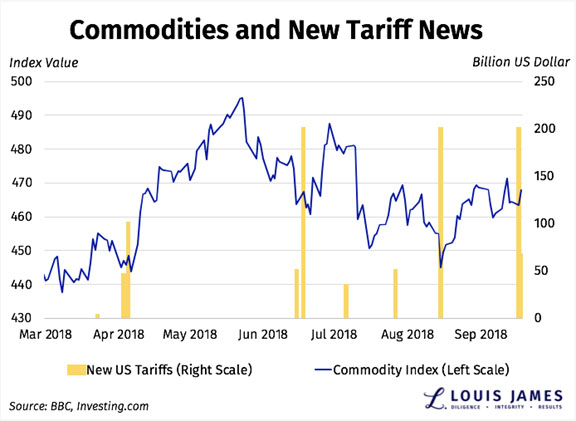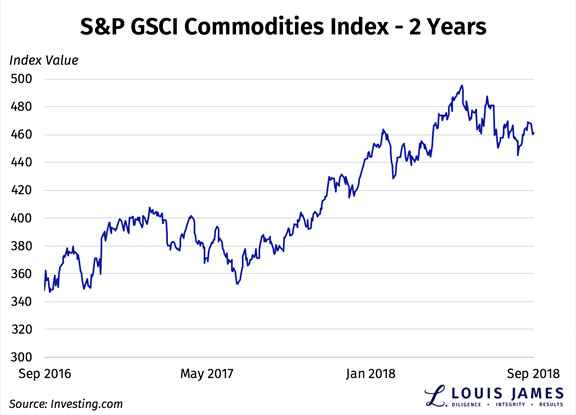Source: Lobo Tiggre for Streetwise Reports 09/19/2018
Lobo Tiggre of the Independent Speculator discusses the trade war and its impact on commodities, and what that all means for resource investors.
There is a widespread notion among investors, analysts and pundits that the escalating trade conflict between the U.S. and its trading partners is bad for the global economy. This is no stretch. The leap from there to it being bad for commodities is understandable, but less certain. Still, people who should know, like those running the world’s largest mining company, are saying it’s so.
Is it any wonder, then, that we’ve seen the rally in commodities that started in 2016 start to peter out?
The chart sure looks like a wave cresting—but how do we know it’s the trade conflict that’s causing it?
In truth, we don’t. But the recent downturn includes commodities facing structural supply deficits, like copper and nickel. That clearly isn’t being driven by fundamentals. This leaves “investor sentiment” as the likely cause—and that’s often driven by perception more than reality. Have a look at this chart, which zooms in on the GSCI Commodities Index since the start of the current trade conflict.

There’s no smoking gun on this chart. In fact, commodities rose after the U.S. fired the first salvos in the conflict. On the other hand, the blows kept coming, and their cumulative impact does seem to be weighing on commodities prices.
This much is largely understood. What seems to get left out of this discussion, however, is that the U.S., the EU, China, India and many emerging economies are still reporting economic growth. Problems in Turkey and Argentina do not cancel out the massive growth in so much of the rest of the world.
There’s a problem with believing that the global economy is growing and at the same time believing that there should be lower demand for the raw materials that make that growth possible. One might argue that investors are reacting now to lower demand in the future. Fine. But then why aren’t investors bailing on equities and other assets that would be hurt by the same global economic downturn?
Perhaps the answer is simply that Mr. Market is bipolar, as legendary investor Benjamin Graham once wrote. If so, there’s no use moaning about commodities being down when they shouldn’t be, or equities being up when they shouldn’t be. They are. We play with the cards we’re dealt.
But there’s another, much more fundamental and solid reality here that’s relevant: the world’s population isn’t getting any smaller. Even if global DGP growth stalls, as long as the number of people in the world keeps increasing, that’s bullish for metals, industrial minerals, agricultural commodities and everything else all those people will need. There will always be cycles in commodities markets, of course, but this underlying trend will keep pushing general demand for decades to come.
So What?
What does all this mean, in practical terms, for resource investors?
- It means we should be cautious about speculating in commodities, just because they “should” go up.
- Until the general upward trend for all commodities is reestablished, we invest only in the ones that are already going up.
- For metals investors, that’s uranium and vanadium this year. Vanadium has doubled this year, but it’s a tiny, more speculative market. Uranium is up about 37% this year, but that’s a stellar performance compared to other metals. This makes uranium as the best driver of value in resource stocks at present.
That said, I’m not just arguing for uranium just because it’s up. Its price remains well below the cost of production at a time when demand is increasing. China is building scores of nuclear power plants, and even Japan has plans to re-start 30 of its reactors. The world may someday abandon nuclear fission for power, but that day is decades away. This is why I have had no doubt for years that uranium must rise. What’s different now is that it’s actually happening.
Of course, a rising tide does not lift all ships equally—especially not the ones with holes in their hulls. Picking the right uranium stocks is essential at this time.
Caveat emptor.
If you’d like to be updated on the trends covered in this article, please subscribe to our free, no-spam Speculator’s Digest at www.IndependentSpeculator.com.
Lobo Tiggre, aka Louis James, is the founder and CEO of Louis James LLC, and the principal analyst and editor of IndependentSpeculator.com. He researched and recommended speculative opportunities in Casey Research publications from 2004 to 2018, writing under the name “Louis James.” While with Casey Research, he learned the ins and outs of resource speculation from the legendary speculator Doug Casey. A fully transparent, documented, and verifiable track record is a central feature of IndependentSpeculator.com services going forward. Another key feature is that Mr. Tiggre will put his own money into the speculations he writes about, so his readers will always know he has “skin in the game” with them.
Sign up for our FREE newsletter at: www.streetwisereports.com/get-news
Disclosure:
1) Statements and opinions expressed are the opinions of Lobo Tiggre and not of Streetwise Reports or its officers. The author is wholly responsible for the validity of the statements. Streetwise Reports was not involved in any aspect of the article preparation. The author was not paid by Streetwise Reports LLC for this article. Streetwise Reports was not paid by the author to publish or syndicate this article.
2) This article does not constitute investment advice. Each reader is encouraged to consult with his or her individual financial professional and any action a reader takes as a result of information presented here is his or her own responsibility. By opening this page, each reader accepts and agrees to Streetwise Reports’ terms of use and full legal disclaimer. This article is not a solicitation for investment. Streetwise Reports does not render general …read more
From:: The Gold Report

